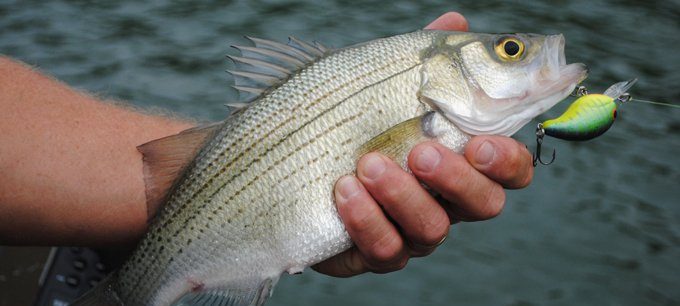White bass are a migratory freshwater fish and a member of the temperate bass family, which also includes the striped bass. White bass is also called silver bass and is the state fish of Oklahoma and the fifth most preferred species among Texas anglers where it’s called sand bass. In order to become a complete pro white bass angler, you need to understand the biology, migratory behavior, their habitat and appropriate fishing techniques, and of course, the best white bass fishing destinations near you.

Table of Contents
Where to find White bass?
You can find a white bass almost all across the United States, especially in the Midwest. They are especially present in Pennsylvania and the area around the Lake Erie, Arkansas River, Lake Poinsett in South Dakota and Detroit River. You can also find silver bass in rivers that flow to Mississippi. Besides their native waters, white bass were introduced in many different waters around the US where they became very popular sport fish.
White bass’ habitat are rivers and large reservoirs. During the spawning period in spring, they are often found in shallow rivers, streams, and creeks.
How Long Do White Bass Live?
Most white bass grow to a length between 10 and 12 inches, although they can reach 17 inches or more.
What is the Biggest White Bass Ever Caught?
There are actually two fish with the same world record size caught on fishing tackle is 6 pounds 13 ounces. One is caught in 1989 in Orange Lake, Virginia and the other in 2010 in Amite River, Louisiana.
Are White Bass Good To Eat?
Yes, white bass are good to eat. Some people don’t like their taste unless it’s prepared the right way. White Bass has a good nutritive value and is rich in vitamin B12.
What Do White Bass Eat?
Silver bass are are schooling fish and they feed in the open water areas of reservoirs and rivers. They feed usually during an early morning or late evening. Young fish feed near shore with live bait such as worms, minnows and insects. Adult bass eat small fish such as shad, silversides, shinners, occasionally young sunfish or even larval insects when necessary.
White Bass Spawn
White bass spawn in freshwater tributaries or on top of rocky shoals in a lake or reservoir. The spawning season occurs in February or early spring in the southern US and in May in the northern US. Silver bass do not build nests or form mating pairs. They lay eggs in clear, relatively shallow water on plants, submerged logs, or rocks. After they mate, parents move to deeper water and don’t care for the young fish. The young white bass live in shallow water for some time until they move to deeper water.
How to Catch White Bass?
White bass can be relatively easy to catch when you locate them. You can catch them on a variety of different lures. White bass spend most of their lives chasing schools of shad, their favorite food. They are most active during dawn and dusk, which means that it is the right time to catch them.
In spring, from January to April, large schools of silver bass concentrate in the far upper ends or river sections of reservoirs making them more accessible to anglers. But, during the rest of the year, sand bass are spread out in larger bodies of water. To locate the school of white bass, you can look for surface activity, such as looking for the diving birds. But it is much easier to have good electronics to find them in big bodies of water. They are usually on the bottom, below the schools of shad, their favorite bait.
White bass fishing during summer changes a lot from early to late summer. Techniques for catching white bass often vary greatly as the temperature of water changes.
A great way to fish during summer nights is under a light at the lake’s surface directed down into the water. Young shad move around the light and you can catch white bass by fishing minnows in the circling mass of shad.
Best White Bass Fishing Lures
There are a variety of lures you can use for white bass, and most of them resemble shad, their favorite bait. White and clear shades are perfect when visibility is low. You can use slab type of lures that can be jigged,, cast or retrieved. Crankbaits and spinners will also work well. Silver bass are not very picky, you just need to find a feeding school and then put something similar to shad in front of them.

